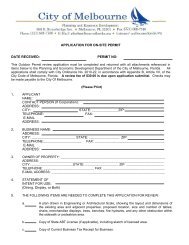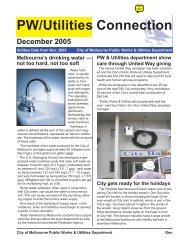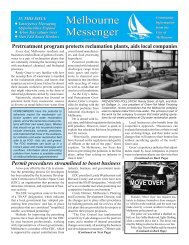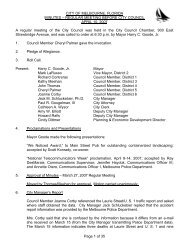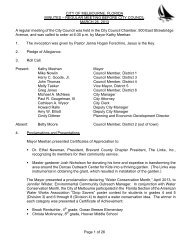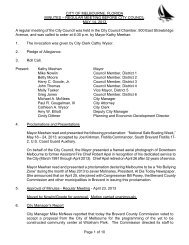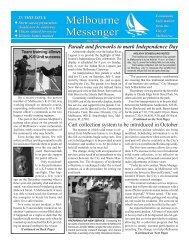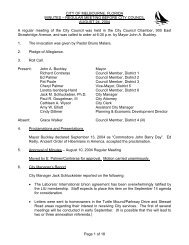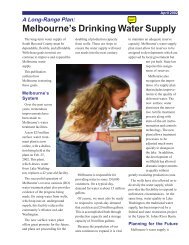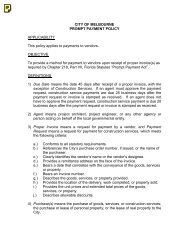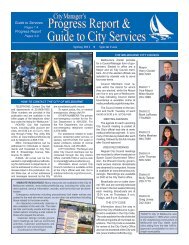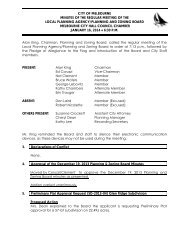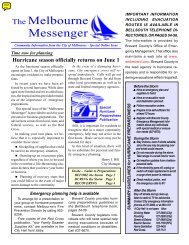Historic Guidelines - City of Melbourne, Florida
Historic Guidelines - City of Melbourne, Florida
Historic Guidelines - City of Melbourne, Florida
You also want an ePaper? Increase the reach of your titles
YUMPU automatically turns print PDFs into web optimized ePapers that Google loves.
APPENDIX<br />
General Terms Defined<br />
public right-<strong>of</strong>-way or the construction <strong>of</strong> a deck to the rear <strong>of</strong> a historic building that does not obscure<br />
architectural features, and that is easily removable.)<br />
Landmark - A designated building, site, or structure having historical, architectural, or archaeological<br />
significance.<br />
Landscape Feature - Individual plants, such as a specimen tree, or groups <strong>of</strong> plants, such as a hedge,<br />
allee, agricultural field, planting bed, or naturally occurring plant community or habitat.<br />
Mitigation - A process designed to prevent adverse impact <strong>of</strong> an activity on cultural resources, by the<br />
systematic removal <strong>of</strong> the prehistoric, historic, or architectural data and materials in order to acquire<br />
the fundamental information necessary for understanding the property within its proper historic<br />
context. For structures, at a minimum, this may require primary archival studies, informant interviews,<br />
measured drawings, and large scale photography. For archaeological sites, at a minimum, this may<br />
require literature studies, informant interviews, field survey, excavation, and artifact analysis. All<br />
mitigation projects require the preparation <strong>of</strong> reports.<br />
National <strong>Historic</strong> Landmark Program - A federal program, which was authorized in 1935 and<br />
implemented in 1960, to identify sites and buildings <strong>of</strong> national significance.<br />
National Register <strong>of</strong> <strong>Historic</strong> Places - Established by Congress in 1935, the National Register <strong>of</strong> <strong>Historic</strong><br />
Places is a listing <strong>of</strong> culturally significant buildings, structures, objects, sites, and districts in the United<br />
States. The listing is maintained by the U.S. Department <strong>of</strong> Interior.<br />
Non-contributing Resource - A building, landscape feature, object, structure or archaeological resource<br />
that does not add to the historic architectural qualities, historic associations, or archaeological values<br />
for which a property is significant because it was not present during the period <strong>of</strong> significance, or it<br />
does not relate to the documented significance <strong>of</strong> the property, and/or due to alterations, disturbances,<br />
additions, or other changes, it no longer possesses historic integrity reflecting its character at that time<br />
or is incapable <strong>of</strong> yielding important information about the period, or it does not independently meet<br />
the National Register criteria. A non-contributing resource shall not be subject to the requirements for<br />
a certificate <strong>of</strong> appropriateness.<br />
DRAFT<br />
Object - A material thing <strong>of</strong> functional, aesthetic, cultural, historical, or scientific value that may be by<br />
nature or design, movable, yet related to a specific setting or environment.<br />
Ordinary Maintenance or Repair - Any work for which a building permit is not required by law, where<br />
the purpose and effect <strong>of</strong> such work is to correct any physical deterioration or damage <strong>of</strong> an element or<br />
any part there<strong>of</strong> by restoring it, as nearly as possible, to its appearance prior to the occurrence <strong>of</strong> such<br />
deterioration or damage.<br />
Preservation - The act or process <strong>of</strong> applying measures necessary to sustain the existing form, integrity,<br />
and materials <strong>of</strong> a historic property. Work, including preliminary measures to protect and stabilize the<br />
property, generally focuses upon the ongoing maintenance and repair <strong>of</strong> historic materials and features<br />
rather than extensive replacement and new construction. New exterior additions are not within the<br />
scope <strong>of</strong> this treatment; however, the limited and sensitive upgrading <strong>of</strong> mechanical, electrical, and<br />
plumbing systems and other code-required work to make properties functional is appropriate within a<br />
preservation project.<br />
Proportions – The relative size <strong>of</strong> two or more dimensions <strong>of</strong> a building; many architectural styles use<br />
highly developed mathematical proportions to determine the composition <strong>of</strong> facades and volumes <strong>of</strong><br />
interior space.<br />
45<br />
Reconstruction - The act or process <strong>of</strong> reproducing, by means <strong>of</strong> new construction, the exact form,<br />
features, and detail <strong>of</strong> a non-surviving building, structure or object or a part there<strong>of</strong>, as it appeared at a<br />
specific period in time.



